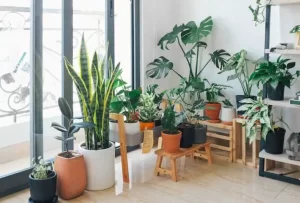Top 5 House Plants Scientifically Proven to Reduce Anxiety and Depression
Breathe in. Breathe out. Now imagine a world where the antidote to stress, anxiety, and the daily blues isn’t found in a pill bottle or a therapist’s office but in the lush, green embrace of your own home.
In a world brimming with screens and the ceaseless hum of modern life, the healing touch of nature has become an elusive necessity. Yet, it’s right within our reach—tucked in the corners of our living spaces, quietly working its magic. Welcome to the enchanting world of houseplants, where science and serenity converge to offer solace for the soul.
 The Science Behind Plant Therapy for the Mind
The Science Behind Plant Therapy for the Mind
The profound connection between nature and mental health has been a subject of fascination for scientists, psychologists, and researchers for decades. At the heart of this phenomenon lies the biophilia hypothesis, a concept introduced by biologist Edward O. Wilson. The hypothesis suggests that humans have an innate, evolutionary connection to the natural world. This connection is not merely a preference but an integral part of our well-being.
Stress Reduction: Scientific studies have demonstrated that exposure to nature, whether through physical immersion in natural settings or the presence of houseplants in indoor environments, can significantly reduce stress. One key mechanism at play is the regulation of cortisol, the body’s primary stress hormone. Time spent in natural surroundings can lower cortisol levels, inducing a state of relaxation and tranquility.
Improved Cognitive Function: Nature has a remarkable ability to enhance cognitive function. Research has shown that interactions with natural elements, such as houseplants, can improve memory, concentration, and problem-solving skills. This phenomenon is linked to the attention restoration theory (ART), which suggests that spending time in natural settings allows the mind to recover from mental fatigue and restore cognitive function.
Emotional Well-Being: The emotional benefits of connecting with nature are equally profound. Exposure to nature has been shown to boost mood, increase feelings of happiness, and reduce symptoms of anxiety and depression. This positive impact on emotional well-being is closely tied to the release of endorphins, serotonin, and other neurotransmitters associated with feelings of pleasure and well-being.
Psychological Benefits: In addition to reducing stress and enhancing mood, the psychological benefits of nature exposure are vast. Studies indicate that regular interaction with natural environments can lead to improved overall mental health. It can reduce symptoms of mental health disorders, enhance self-esteem, and foster a sense of calm and tranquility.
Biophilic Design: The concept of biophilic design takes these scientific findings into account. It involves intentionally incorporating natural elements, such as houseplants, into indoor environments to promote mental and emotional well-being. By strategically integrating nature into our living spaces, we can harness its restorative powers and create environments that support our mental health.
Top 5 Houseplants that Alleviate Anxiety and Depression
Discover the green therapy you need! Here are the top five houseplants that offer natural relief from anxiety and depression.
1. Lavender
With its soothing scent and calming properties, lavender has long been hailed for its ability to reduce anxiety and promote relaxation. Numerous studies have shown that the aroma of lavender can significantly lower levels of stress hormones and improve overall mood. Consider placing a potted lavender plant in your bedroom or living room for a natural way to unwind and de-stress.
Lavender Care Tips:
To ensure its well-being, place your lavender in a sunny spot near a south-facing window where it can bask in 6-8 hours of direct sunlight daily. When it comes to watering, allow the soil to dry out between waterings to prevent overwatering, and make sure the pot has proper drainage.
Lavender thrives in well-draining soil, so consider using a mix of potting soil and perlite or sand. Regularly prune back spent blooms to encourage new growth and maintain the plant’s shape. Keep your indoor temperature around 60-70°F (15-24°C), and lavender will thrive in average indoor humidity levels.
2. Snake Plant
Also known as “Mother-in-Law’s Tongue,” the snake plant is a popular choice for indoor gardening enthusiasts. Aside from its low-maintenance nature, this plant has been found to purify the air by removing harmful toxins and releasing oxygen. Improved air quality can have a positive impact on mental health, alleviating symptoms of anxiety and depression. Place a snake plant in your home office or bedroom for cleaner and fresher air.
Snake Plant Care Tips:
Snake plants are low-maintenance houseplants that can adapt to various light conditions. While they can tolerate low light, they prefer bright, indirect sunlight. They’re forgiving when it comes to watering—let the soil dry out completely between waterings to prevent overwatering, and ensure the pot has drainage holes to prevent root rot.
Use a well-draining potting mix, and repot only when the plant becomes root-bound every 2-3 years. Snake plants can thrive in temperatures between 70-90°F (21-32°C) and are quite adaptable to different humidity levels.
3. Aloe Vera
Beyond its skincare benefits, aloe vera is a powerhouse when it comes to improving indoor air quality. This succulent plant has been found to effectively absorb harmful pollutants such as formaldehyde and benzene, which are commonly found in cleaning products and synthetic materials. By reducing airborne toxins, aloe vera can create a healthier and more tranquil environment, promoting a sense of calm and well-being.
Aloe Vera Care Tips:
Aloe vera thrives in bright, indirect sunlight. Place it near a sunny windowsill for optimal growth. When it comes to watering, allow the soil to dry out entirely between waterings to prevent root rot. Use a well-draining cactus or succulent mix in a pot with good drainage. Aloe vera prefers warm temperatures between 68-80°F (20-27°C) and is relatively low-maintenance when it comes to humidity. Repot only when necessary, typically every few years, as it doesn’t require frequent repotting.
4. Peace Lily
The graceful peace lily not only adds elegance to any space but also acts as a natural air purifier. This plant has been shown to remove volatile organic compounds (VOCs) from the air, including benzene, toluene, and xylene. These chemicals can be found in household products such as paint, cleaning agents, and even some furniture. By eliminating these harmful substances, the peace lily contributes to a healthier indoor environment, supporting mental well-being.
Peace Lily Care Tips:
Peace lilies are elegant, air-purifying plants that thrive in moderate to low light conditions. Place them in a spot with indirect sunlight to maintain their vibrant green leaves and occasional white blooms. When it comes to watering, keep the soil consistently moist but not waterlogged. Ensure your pot has drainage holes, and avoid letting the plant sit in standing water. Peace lilies are not fussy about soil type but prefer a well-draining mix. Keep indoor temperatures between 65-80°F (18-27°C), and they will flourish in average indoor humidity levels.
5. Spider Plant
Known for its ability to reproduce rapidly, the spider plant is an excellent choice for beginners in indoor gardening. But its benefits extend beyond aesthetics and ease of care. Research has shown that spider plants can effectively remove carbon monoxide and other toxins from the air, helping to create a clean and fresh environment. Breathing cleaner air can contribute to a sense of calm and reduce the symptoms of anxiety and depression.
Spider Plant Care Tips:
Spider plants are hardy and adaptable houseplants. They thrive in bright, indirect light but can tolerate lower light conditions. Water them moderately, allowing the top inch of soil to dry out between waterings. Use well-draining potting soil and a container with drainage holes. Spider plants do well at indoor temperatures between 60-75°F (15-24°C) and are comfortable with average indoor humidity. Repot them when they become root-bound, typically every 2-3 years, to maintain their health and vitality.
The Undeniable Magic of Houseplants
Houseplants play a pivotal role in biophilic design and the pursuit of improved mental health. They not only add aesthetic appeal to indoor spaces but also improve air quality, reduce stress, and enhance overall well-being. The scientific evidence supporting the benefits of houseplants serves as a testament to their role as natural healers within our homes.
Understanding the science behind the connection between nature and mental health underscores the importance of integrating nature, including houseplants, into our daily lives. It reaffirms that our innate bond with the natural world is not only a source of beauty and solace but also a powerful tool for enhancing our mental and emotional well-being. By nurturing this connection, we can cultivate a healthier, happier, and more balanced life.












